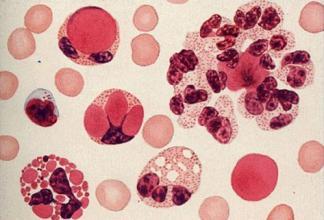SCI论文(www.lunwensci.com):
摘要:凋亡碎片清除障碍,引发了免疫系统的活化导致了SLE的自身免疫应答,从而促进SLE的发生发展。补体是固有免疫防御系统的第一道防线,Pentraxins作为一种可溶性模式识别分子与补体相互作用参与识别和消灭入侵的病原体和凋亡碎片,并调节相关炎症。本综述主要阐述Pentraxin 3对凋亡细胞的作用,同时阐释与补体的相互作用及在系统性红斑狼疮中研究进展。
关键词:系统性红斑狼疮;Pentraxin 3;补体系统
本文引用格式:蔡胜,李振英.Pentraxin 3与补体的相互作用在系统性红斑狼疮中研究进展[J].世界最新医学信息文摘,2019,19(98):147-149.
Research Progress on the Interaction between Pentraxin 3 and Complement in Systemic Lupus Erythematosus
CAI Sheng,LI Zhen-ying*
(The First Affiliated Hospital of Jiamusi University,Jiamusi Heilongjiang)
ABSTRACT:The obstacle of clearing apoptosis debris leads to the activation of the immune system,which leads to the autoimmune response of SLE and promotes the occurrence and development of SLE.Complement is the first defense line of innate immune defense system.Pentraxins,as a soluble pattern recognition molecule,interact with complement to recognize and eliminate invading pathogens and apoptotic fragments,and regulate related inflammation.This review focuses on the role of pentraxin 3 in apoptotic cells,the in-teraction with complement and the research progress in systemic lupus erythematosus.
KEY WORDS:Systemic lupus erythematosus;Pentraxin 3;Complement system
引言
系统性红斑狼疮(Systemic lupus erythematosus,SLE)是一种由免疫系统介导的全身多器官受累的自身免疫性结缔组织疾病。SLE呈高度异质性,临床表现上个体差异性大,轻重不一。本病的分子机制尚未阐明,越来越多的证据表明,环境因素及遗传易感性所致的免疫细胞异常、细胞凋亡失调和凋亡物质清除缺陷均与SLE的发生发展有关[1]。死亡细胞清除功能受损可能导致SLE组织中凋亡细胞的堆积,而这些细胞的继发性坏死同样是SLE慢性炎症的其中的一个原因。血清因子如补体、Pentraxins有助于凋亡和坏死细胞的有效调理和摄取。研究发现,SLE患者取组织学活检可发现的凋亡细胞清除受损,现就Pentraxin 3功能及与补体相互作用对凋亡细胞的清除作用做一总结。
1 Pentraxin 3与细胞凋亡及免疫防御
Pentraxin 3是正五聚体结构蛋白家族其中一个重要成员。所有的Pentraxins家族都含有大约200个氨基酸长的Pentraxins结构域,而长的Pentraxin 3具有独特的N端结构域。它作为一种正五聚体结构蛋白,最先是由Breviario等通过白细胞介素1β诱导脐静脉内皮细胞以及Lee等通过肿瘤坏死因子α诱导成纤维细胞时所发现的炎症反应蛋白[2、3]。长五聚体Pentraxin 3主要由免疫细胞内皮细胞产生,如巨噬细胞、中性粒细胞、树突状细胞和内皮细胞[4]。固有免疫是保护机体不受微生物入侵和防止组织损伤的第一道防线,Pentraxin 3在固有免疫中起着激活补体和促进吞噬细胞识别病原体的作用。Pentraxin 3通过不同机制发挥促进吞噬、募集白细胞及调节补体活性的作用,进而清除入侵的微生物。与家族的其他成员相似,Pentraxin 3能与凋亡细胞结合,从而抑制凋亡细胞被树突状细胞吞噬。在凋亡后期,Pentraxin 3在与凋亡细胞结合的同时,增强了树突状细胞分泌细胞因子[5]。细胞内的Pentraxin 3易聚集于凋亡晚期的中性粒细胞表面,并作为自噬分子被巨噬细胞识别和捕获,进而清除凋亡细胞。凋亡细胞与Pentraxin 3结合,增强了C1q与Pentraxin 3的结合以及C 3在细胞表面的沉积,表明Pentraxin 3在补体介导的凋亡细胞清除中具有作用[6]。当细胞接近死亡时,Pentraxin 3一定程度上能够阻止来自将死细胞的抗原交叉呈递,说明Pentraxin 3有助于限制炎症条件下的组织损伤及自身反应性T细胞激活[7]。Pentraxin 3与凋亡细胞结合,帮助吞噬细胞识别和清除,促进组织愈合。
2 Pentraxin 3与补体系统
在人类中,补体系统最早于1895年被发现作为抗体介导免疫的不耐热效应物。从那时起,补体已经经历了100多年来揭[8]示其真正的功能。现如今,补体主要生理功能为免疫防御功能,其在体内具有强化吞噬、增强吞噬细胞的趋化性、免疫复合物的溶解、中和病毒、免疫反应的调节等作用,在机体免疫防御机制中举足轻重,对消除外来因素,特别是抗原侵害,维护机体内环境平衡具有重要作用[9]。补体遍及人体血液、组织液及细胞膜表面,是机体精密调控的防御体系。补体在精确的平衡控制下,通过有效的激活和调节规则发挥其功能。激活部分包括三个途径:经典途径、凝集素途径和替代途径。路易斯·皮勒默证明,补体系统可以独立于抗体被所谓的“properdin”系统激活,从而在固有免疫中发挥中心作用[10]。补体还将固有免疫系统和适应性免疫系统紧密地联系在一起,例如,在抗原识别和向适应性免疫系统参与者传递抗原方面。补体调节缺陷也会导致免疫碎片的积聚,从而导致自身免疫性疾病。例如,编码经典途径成分的基因纯合子缺陷与SLE密切相关[11、12]。免疫复合物的不能被有效清除,B细胞对自身的识别缺陷和对死亡细胞的处理效率低下,从而导致自身免疫性疾病。
目前知道,C1q是Pentraxin 3最常见的一种配体,微生物与特异性抗体结合形成C1q的结合位点,进一步激活经典补体途径。C1q作为经典补体途径的起始成分,在固有免疫和适应性免疫应答中也表现出多种补体独立的活性。众所周知,免疫细胞的异常调节和内环境平衡的破坏导致包括狼疮在内的自身免疫性疾病。系统性红斑狼疮(SLE)是一种以清除障碍和继发性自身免疫为特征的疾病。研究发现,C1q基因缺陷易导致SLE。Pentraxin 3调节与病原体和死亡细胞的C1q结合,并调节吞噬细胞对其的摄取。它还抑制p-选择素介导的白细胞募集。这两种机制都与自身免疫和自身免疫组织损伤有关,例如SLE。Lech M等[13]为评估Pentraxin 3在自身免疫中的潜在免疫调节作用,将Pentraxin 3缺陷小鼠与fas缺陷(lpr)c57bl/6(b6)小鼠与轻度狼疮样自身免疫小鼠杂交。随着疾病的进展,Pentraxin 3在b6lpr的肾脏和肺组织中表达增加。Pentraxin 3缺乏也加重了b6lpr小鼠的自身免疫性肺病,总之,Pentraxin 3特异性抑制与系统性红斑狼疮相关的自身免疫性肺病。故Pentraxin 3基因功能缺失突变可能是系统性狼疮或其他自身免疫性疾病肺部表现的遗传危险因素。C1q与凋亡和坏死细胞释放的分子结合,包括磷脂酰丝氨酸、核酸和其他损伤相关分子模式。C1q诱导巨噬细胞表达酪氨酸激酶,从而增强清除凋亡碎片的能力,由于凋亡细胞可以通过结合C1q激活补体,而Pentraxin 3可以结合凋亡细胞,在Pentraxin 3的作用下,C1q的结合增强。补体促进吞噬细胞摄取凋亡细胞,其他研究表明Pentraxin 3与凋亡细胞结合。Pentraxin 3与凋亡细胞的结合和补体激活的增强提示Pentraxin 3与补体经典途径成分协同促进凋亡细胞的清除,可能抑制自身免疫机制。另外,Pentraxin 3对专业抗原提呈细胞摄取凋亡细胞具有抑制作用,这可能与保护自身免疫反应的发生有关[14]。
3补体系统与系统性红斑狼疮
研究发现,固有免疫和适应性免疫应答的活化对SLE的自身免疫应答来说,缺一不可。补体级联反应是固有免疫系统的一部分[15]。经典途径的启动子C1q的遗传缺陷对SLE有强烈的易感作用。几乎所有的C1q缺乏症患者发展为系统性红斑狼疮。C1qa和C1qb基因中的两个新突变最近被发现导致C1q缺乏[16,17],这是对先前报道的突变的补充[18]。C1q基因中的另一个突变导致功能缺陷。C1q仍能与凋亡细胞结合,但不能与C1r和C1s结合,因而不能激活补体。C2、C4的缺乏患SLE的风险会增加,并且同时合并抗C1q抗体和抗心磷脂抗体阳性[19]。而C4存在两种亚型C4a和C4b中表达,故C4完全缺失是相当罕见的,其中发现C4a高基因拷贝数具有保护作用[20]。另一方面,C4b基因的拷贝数与SLE无关[21]。
致病性自身抗体存在于每一个SLE患者中,故在SLE中B细胞的作用不言而喻。补体可以影响B细胞和T细胞的激活。适当的B细胞成熟依赖于通过暴露于自身抗原而对自身反应细胞的阴性选择,补体将这种抗原传递给B细胞。在SLE中可以发现,补体的缺乏导致自身抗原较少暴露于b细胞,增加了自身反应b细胞发育的风险[22]。C3d可改变T细胞功能,C3d沉积可导致T细胞内ca2+释放减少,从而导致炎症细胞因子的产生增加[23]。补体还能激活系统性红斑狼疮患者的T细胞。血清干扰素-α水平升高与I型INF系统的参与是SLE的一个重要特征,越来越受到重视。有趣的是,长期干扰素-α治疗也可能诱发SLE样症状。干扰素-α被认为来源于免疫复合物刺激后活化的浆细胞样树突状细胞(pDCs),血清干扰素-α活性与自身抗体水平相关[24]。
4中性粒细胞胞外诱捕网
中性粒细胞胞外诱捕网(NETs)是网状结构,由DNA、组蛋白和杀菌蛋白组成,由中性粒细胞通过一种叫做NETosis的独特凋亡途径产生[25、26、27]。NETs由染色质和抗微生物酶组成,是SLE的抗原靶点。SLE更容易形成网状物,特别累及肾脏时,患者无法降解网状物[28]。网状物可通过Toll样受体7/9进一步激活pDCs,从而导致SLE中观察到的IFN-α释放。NETs还通过C1q激活补体,C1q还可防止NETs单独或与自身抗体结合降解[29]。C1q有助于巨噬细胞清除NETs,因此减少的降解可能是适当吞噬的权衡[30]。NETs在SLE中的作用最近发展成为新的研究领域。发现Pentraxin 3与NETs相关的杀菌蛋白形成复合物,即azurocidin 1(azu1)和髓过氧化物酶。azu1与Pentraxin 3之间存在钙依赖性的高亲和力结合,该结合特别涉及Pentraxin3的n端结构域。Pentraxin 3在NETs中的功能有待进一步研究。NETs的产生可以通过中性粒细胞与血管内皮细胞、活化的血小板,或者各种细胞因子的相互作用而诱导。也有数据也表明核小体和含有RNA的免疫复合物可诱导NETosis形成。NETs能诱导pDCs产生的I型干扰素。作为自身抗原呈递给T淋巴细胞,并介导血管损伤和血栓形成。
5 总结与展望
Pentraxin 3作为一种急性期反应蛋白,在炎症及组织损伤中均可产生。在清除细胞碎片及在补体系统中起着重要的作用。
由不少研究已经证实,处于活动期SLE患者Pentraxin 3的水平明显高于健康对照组,并且可以作为疾病活动的指标。同时也可以作为在疾病诊断、病情监测、预后判断等的辅助检查指标。其临床应用方面仍待进一步研究。补体C1q在SLE中地位也尤为重要。正如前面所述,固有免疫及适应性免疫在SLE免疫应答中缺一不可,Pentraxin 3能够限制炎症条件下的组织损伤和自身反应性T细胞的激活作用,此作用有待进一步研究。
参考文献
[1]Haijing Wu,Siqi Fu,Ming Zhao,et al.Dysregulation of Cell Death and ItsEpi-geneticMechanisms in Systemic Lupus Erythematosus[J].Molecules,2016,22(1):223-245.
[2]Breviario F,d'Aniello EM,Golay J,et al.Interleukin-1-inducible genes in en-dothelial cells.Cloning of a new gene related to C-reactive protein and serum amyloid P component[J].J Biol Chem,1992,267(31):22190-22197.
[3]Lee GW,Lee TH,Vilcek J.TSG-14,a tumor necrosis factor-and IL-1-inducible protein,is a novel member of the pentaxin family of acute phase proteins[J].J Immunol,1993,150(5):1804-1812.
[4]Mantovani A,Garlanda C,Doni A,and Bottazzi B.Pentraxins in innate im-munity:from C-reactive protein to the long pentraxin PTX3[J].J Clin Immu-nol,2008,28:1-13.
[5]Deban L,Jarva H,Lehtinen MJ,et al.Binding of the long pentraxin PTX3 to factor H:Interacting domains and function in the regulation of complement activation[J].J Immunol,2008,181(12):8433-8440.
[6]Jaillon S,Jeannin P,Hamon Y,et al.Endogenous PTX3 translocates at the membrane of late apoptotic human neutrophils and is involved in their en-gulfment by macrophages[J].Cell Death Differ,2009,16(3):465-474.
[7]Baruah P,Propato A,Dumitriu IE,et al.The pattern recognition receptor PTX3 is recruited at the synapse between dying and dendritic cells,and edits the cross-presentation of self,viral,and tumor antigens[J].Blood,2006,107(1):151-158.
[8]Walport MJ.Complement.First of two parts[J].N Engl J Med,2001,344:1058–66.
[9]Melis J,Strumane K,Ruuls SR,et al.Complement in therapy and disease:Regulating the complement system with antibody-based therapeutics[J].Mol Immunol,2015,67(2PtA):117-130.
[10]Gal P,Dobo J,Beinrohr L,et al.Inhibition of the serine proteases of the com-plement system[J].Adv Exp Med Biol,2013,735:23-40.
[11]Bao L,Haas M,Quigg RJ.Complement factor H deficiency accelerates devel-opment of lupus nephritis[J].J Am Soc Nephrol,2011,22:285-95.
[12]Truedsson L,Bengtsson AA,Sturfelt G.Complement deficiencies and system-ic lupus erythematosus[J].Autoimmunity,2007,40:560-6.
[13]Lech M,Rommele C,Kulkarni OP,et al.Lack of the long pentraxin PTX3 promotes autoimmune lung disease but not glomerulonephritis in murine systemic lupus erythematosus[J].PLoS ONE,2011,6:e20118.
[14]Rovere,P,Peri,G,Fazzini,F,The long pentraxin PTX3 binds to apoptotic cells and regulates their clearance by antigen-presenting dendritic cells[J].Blood,2000,96:4300–4306.
[15]Ricklin D,Hajishengallis G,Yang K,et al.Complement:a key system for im-mune surveillance and homeostasis[J].Nat Immunol,2010,11:785–97.
[16]Namjou B,Keddache M,Fletcher D,et al.Identifification of novel coding mutation in C1qA gene in an African-American pedigree with lupus and C1q defificiency[J].Lupus,2012,21:1113–18.
[17]Higuchi Y,Shimizu J,Hatanaka M,et al.The identifification of a novel splicing mutation in C1qB in a Japanese family with C1q defificiency:a case re-port[J].Pediatr Rheumatol Online J,2013,11:41.
[18]Schejbel L,Skattum L,Hagelberg S,et al.Molecular basis of hereditary C1q defificiency—revisited:identifification of several novel disease-causing muta-tions[J].Genes Immun,2011,12:626–34.
[19]Jonsson G,Sjoholm AG,Truedsson L,et al.Rheumatological manifesta-tions,organ damage and autoimmunity in hereditary C2 defificien-cy[J].Rheumatology(Oxford),2007,46:1133–9.
[20]Kim JH,Jung SH,Bae JS,et al.Deletion variants of RABGAP1L,10q21.3,and C4 are associated with the risk of systemic lupus erythematosus in Korean women[J].Arthritis Rheum,2013,65:1055–63.
[21]Yang Y,Chung EK,Wu YL,et al.Gene copy-number variation and associated polymorphisms of complement component C4 in human systemic lupus erythematosus(SLE):low copy number is a risk factor for and high copy number is a protective factor against SLE susceptibility in European Ameri-cans[J].Am J Hum Genet,2007,80:1037–54.
[22]Carroll MC.A protective role for innate immunity in systemic lupus erythe-matosus[J].Nat Rev Immunol,2004,4:825–31.
[23]Borschukova O,Paz Z,Ghiran IC,et al.Complement fragment C3d is coloca-lized within the lipid rafts of T cells and promotes cytokine produc-tion[J].Lupus,2012,21:1294–304.
[24]Weckerle CE,Franek BS,Kelly JA,et al.Network analysis of associa-tions between serum interferon-alpha activity,autoantibodies,and clinical fea-tures in systemic lupus erythematosus[J].Arthritis Rheum,2011,63:1044–53.
[25]Brinkmann V,Reichard U,Goosmann C,et al.Neutrophil extracellu lar traps kill bacteria[J].Science,2004,303:1532–1535.
[26]Kaplan MJ,Radic M.Neutrophil extracellular traps:double-edged swords of innate immunity[J].J Immunol,2012,189:2689–2695.
[27]Urban CF,Ermert D,Schmid M,et al.Neutrophil extracellular traps contain calprotectin,a cytosolic protein complex involved in host de fense against Candida albicans[J].PLoS Pathog,2009,5:e1000639.
[28]Garcia-Romo GS,Caielli S,Vega B,et al.Netting neutrophils are major induc-ers of type I IFN production in pediatric systemic lupus erythematosus[J].Sci Transl Med,2011,3:73ra20.
[29]Lefflfler J,Martin M,Gullstrand B,et al.Neutrophil extracellular traps that are not degraded in systemic lupus erythematosus activate complement exacer-bating the disease[J].J Immunol,2012,188:3522–31.
[30]Farrera C,Fadeel B.Macrophage clearance of neutrophil extracellular traps is a silent process[J].J Immunol,2013,191:2647–56.
关注SCI论文创作发表,寻求SCI论文修改润色、SCI论文代发表等服务支撑,请锁定SCI论文网! 文章出自SCI论文网转载请注明出处:https://www.lunwensci.com/yixuelunwen/25389.html


